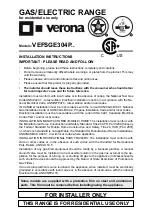
S
AFETY
17
Load Operation
The weight of cargo and occupants affects vehicle operation. Carefully calculate how the vehicle is loaded and how to
safely operate it. Follow the instructions in this manual for loading guidelines and tire pressure.
Do not exceed weight capacities specified for your vehicle. Capacities are listed in
on page 15 of this manual, and also on the label affixed to rear hand rail. As passenger weight
increases, cargo weight needs to be adjusted to ensure the maximum vehicle weight capacity is not exceeded.
Tire pressure must be adjusted to accommodate the load being carried. See
on page 15 for pressure
specifications.
Verify tire pressure, and drive slowly and carefully to maintain control of the vehicle if driving under any of the following
conditions:
• passenger and/or cargo exceeds half the maximum weight capacity
• driving over obstacles
• towing
• climbing a hill
Driving in Reverse
Make sure the area behind the vehicle is clear before operating in reverse. After making sure it is clear and safe to
operate in reverse, accelerate slowly. Avoid making sharp turns in reverse. Refer to
on page 30 for
operational information.
Driving a Damaged Vehicle
Driving a damaged vehicle is not safe.
If the vehicle has been involved in any type of accident, have it inspected by a qualified service dealer to verify that it
is safe for operation.
Driving at Maximum Speeds
Maximum speed operation increases the risk of loss of control. Always drive at a speed that is appropriate for the ter
-
rain, visibility, operating conditions, and your skill and experience level. Use the brake to control speed and maintain
control of the vehicle.
Driving on Pavement
Driving the vehicle on paved surfaces can affect handling characteristics and increase tire wear.
If possible, avoid driving on paved surfaces. If unavoidable, drive slowly, travel short distances, and avoid sudden
turns or stops.
Driving on Public Roads
Driving this vehicle on public streets, roads or highways could result in a collision with another vehicle. Never drive this
vehicle on any public street, road, or highway, including dirt and gravel roads, unless they are designated for off road
use. Most areas prohibit the operation of this vehicle on public streets, roads, or highways and can result in traffic vio
-
lations and fines.
Turning
Improper or careless turning can cause loss of traction, loss of control, accident, or rollover. Do not turn quickly or at
sharp angles. Do not turn at high speeds. Practice turning at slow speeds before attempting to turn at faster speeds.
Driving Uphill
Do not climb hills that are too steep for the vehicle or your driving abilities. Loss of vehicle control or rollover can result
from climbing hills incorrectly. Refer to
on page 29 for operational information.
Driving Downhill
Inspect the terrain before descending a hill. Avoid driving across hills. Use the brake to limit speed and maintain con
-
trol. Loss of vehicle control or rollover can result from driving downhill incorrectly. Refer to
for operational information.
Stalling on a Hill
A rollover can result from stalling or rolling backward while climbing a hill. Drive uphill at a constant speed. See proce
-
dure on page 30 for maintaining control of your vehicle if it stalls on a hill.
Summary of Contents for Express S6 ELiTE
Page 1: ...10013988 B ISSUED JANUARY 2021 OWNER S MANUAL Express S6 ELiTE ...
Page 8: ...6 TABLE OF CONTENTS ...
Page 12: ...10 INTRODUCTION ...
Page 16: ...14 MAINTENANCE ...
Page 22: ...20 SAFETY ...
Page 26: ...24 FEATURES AND CONTROLS ...
Page 48: ...46 MAINTENANCE ...
Page 52: ...50 MAINTENANCE LOG DATE MILES KM AND HOURS TECHNICIAN SERVICE PERFORMED COMMENTS ...
Page 53: ...MAINTENANCE LOG 51 DATE MILES KM AND HOURS TECHNICIAN SERVICE PERFORMED COMMENTS ...
Page 54: ...52 MAINTENANCE LOG DATE MILES KM AND HOURS TECHNICIAN SERVICE PERFORMED COMMENTS ...
















































